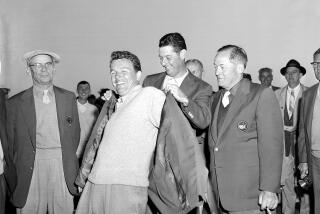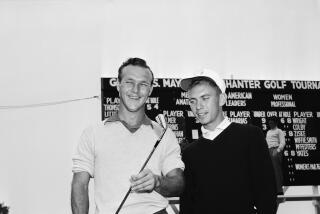Relationship Makes the Cut in Scotland
- Share via
ST. ANDREWS, Scotland — My father first put a golf club in my hand when I was 5, and I spent childhood summers on a hot, windy golf course in Kansas, playing with my buddies or carrying clubs for my father. When I started playing in junior tournaments, though, I had some bad news for Dad: If he insisted on watching me play, he was going to have to stay out of sight. And so he dutifully skulked through the rough, peering from behind trees and feeling the pressure of every one of my putts.
As time passed, I left the Plains behind for life in New York, Chicago, Nairobi, Johannesburg, Paris and, finally, Los Angeles. I played less and less while, back home, my father played more and more.
Before I knew it, a few decades had disappeared. This spring, when I turned 50 and my father 75, my wife suggested I invite Dad to play golf in Scotland, the home of the sport, a forbidding land of thick gorse and deep bunkers. If not now, she said, when? So, I asked Dad to take a walk down memory’s fairway, to replay one of those father-son tournaments before it was too late. “Let’s do it,” he said.
To be honest, I wasn’t sure how this would work out. We couldn’t be more different, my father and I. He grew up on a farm, tending wheat and milking cows. But he raised us in suburbia, a block from a country club. He was the youngest of three kids. I was the oldest of three. He washed dishes to put himself through college, the first person in his family to go. When I went to college, Dad picked up most of the tab. He had spent his career as an oilman and, eventually, a company president. I’d spent mine as a newspaper writer and editor. We didn’t agree on politics. We rarely saw eye-to-eye on religion. But we did have one thing going for us: We both liked to play golf.
*
Two weeks ago, we met at the airport in Glasgow, a twosome with tee times on six of the world’s most famous links courses, five nights of hotel reservations and stockpiles of Advil. It was a trip neither of us will soon forget.
As the one with experience driving on the left, I took the wheel of our tiny rental car and sped southwest through the misty countryside. The left-side driving took some getting used to for my passenger. “This scares the heck out of me,” Dad said.
Our journey began on the west coast, at Turnberry and Troon, and ended on the east coast, at Carnoustie and St. Andrews, site of the British Open next month.
By afternoon of the first day, we were standing on the first tee of Ailsa, the championship course at Turnberry, population 192, where Tom Watson, Greg Norman and Nick Price had won British Opens. We were prepared for the worst kind of weather, and our bags were loaded with windbreakers, sweaters and full-body rain gear. But the clouds parted and a gentle breeze drifted off the Firth of Clyde.
“Like this all the time?” I asked the starter. “Aye, there’s sun here all the time. Sometimes, it just hides behind the clouds.” He paused. “That’s why our faces look this way,” he added, pointing to his puffy, red cheeks. “Rust, you know.”
Scotland is renowned for its links courses, situated on the sandy land that provides a bridge, or link, between the cold sea and the rich inland farmland. For the most part, the links are treeless, wind-swept expanses, thinly brushed with grass and edged with spiny gorse. These golf courses could never be called lush. They are pocked with bunkers, from small, deep traps the caddies call “coffins” to fairway-wide behemoths.
But, as everyone who has ever watched a British Open knows, the real hazard is the weather. Rain is always a threat and the wind can blow with gale force, switching directions in mid-swing. With narrow fairways and unplayable rough, even a gentle breeze here is a force to be reckoned with. As the Scots like to say, “If there is nae wind, there is nae golf.”
Electric carts are forbidden on most of the top Scottish courses, so we opted for caddies, who saved our fragile knees and, more crucially, serenaded us with a combination of information and entertainment. Watching my father, the plain-spoken oilman, interact with the droll, waggish Scottish caddies was like watching the characters from “Dallas” crash an episode of “Upstairs, Downstairs.”
When Dad blamed a short missed putt on the “yips,” his Troon caddie nodded in agreement. “There was a wee bit of a tick in the stroke,” he said. When another shot landed in a bunker, Dad’s caddie wryly observed: “You haven’t been in one of those for a few holes.”
But the caddies learned a few aphorisms from the Kansan too. When a course marshal asked how he was playing, Dad drew appreciative laughter with one of his favorite expressions from back home: “I know I can play better than this,” he said. “I just never have.”
On our first day, my father drew a caddie named Jack Dunlop, a salty, 77-year-old former bus driver who knew every inch of Turnberry. (The caddiemaster had warned us, deadpan: “Other than being blind and deaf, Jack’s a good caddie.”) Perhaps more important, Jack knew every thicket where a 70-something bladder could be relieved in relative privacy.
As seagulls glided by on the par-four eighth hole, Dad skulled a shot that, by luck, wound up close to the pin. “Nice shot, young man,” Jack said. “It isn’t how good you hit your good shots,” Dad told him. “It’s how good you hit your bad shots.” “Aye,” Jack replied. (Watching a similar shot later at St. Andrews, a caddie reminded Dad: “There are no pictures on the scorecard, Marvin.” My father turned to me and said, “Write that one down.”)
That first night, we watched the sun set over the ocean at 10:30, and talked -- about family, about work and about the magic of playing golf in Scotland.
The next day, we trekked to Royal Troon, a private club, to play 36 holes -- on the Portland course and the famed Old Troon. Getting tee times on Old Troon had been a challenge; visitors reserve months in advance for four-hour windows, three days a week. We lucked into a tee time because of a late cancellation.
Again, the weather was spectacular, the air fragrant with the almond-scented flowers of the gorse. “It’s always like this, right?” I teased the Troon starter. He fixed me with a solemn gaze. “Whoever told you that is a bloody liar,” he said.
Early on, I shanked a wedge out of the gorse, hitting my father with a line drive to the chest. Dad called the resulting bruise his “souvenir.” It didn’t hurt his game, though. He hit his approach shot for a gimme par, prompting his caddie to give me some advice: “Smack him again on the next tee and he’ll make a birdie.”
One of my Dad’s golfing partners back home had scoffed at the idea of flying to Scotland to play links golf. “Goat tracts,” the friend called them.
Old Troon may have once been, literally, a goat tract. But it is now a challenging and beautiful links course, and one inhabited, like so many of the courses here, by the ghosts of golfing greats. We imagined the packed stands on Troon’s finishing holes and the pros who had walked these same fairways in eight British Opens, lining up their tee shots, as we did, on landmarks like the Prestwick church spire. “That bunker over there we call Johnny Miller’s bunker,” my caddie, Colin Ferguson, told me on the 18th. “He left a six-iron in it and it cost him the Open.”
*
We grew up a golfing family, which was Dad’s doing. He was 27 when he took up the game and, regretting that he hadn’t learned it sooner, resolved to get his children proper instruction early. My brother Alan’s name is still affixed to a plaque at our home course, where he won the club championship at 19. My sister, Natalie, played for the high school golf team. My mother, Pat, took the game up, in self-defense I suspect, and has become a good playing partner for my father. He plays to an 11 handicap, slightly higher than mine.
Dad charmed his caddies by spinning stories of our golfing family and of his childhood, tales I hadn’t heard in years. As the young son of German immigrants, he went to school speaking barely a word of English. Coming home from kindergarten, he would insist that my grandparents stop speaking German. “This is America. We speak English.”
My father’s parents and siblings are gone now, but Dad has kept the small family wheat farm in western Kansas, more for sentimental than financial reasons. Explaining that to his St. Andrews caddie, Donald McInnes, Dad grumbled about the cost of pesticides, seed and taxes. To which Donald observed impishly: “You talk anymore and I’ll have to get me hanky out.” He went on to suggest Dad try his hand at selling used cars.
At first, the cost of our trip, made worse by the dollar’s sickly performance abroad, had given us pause. Green fees averaged about $200 and each caddie added another C-note per round. Although my father has always described me as a man “of champagne tastes on a beer salary,” even I was taken aback by a price tag of $6.50 for a tall latte at Starbucks or a gallon of gasoline.
Soon, though, it became clear that this trip was worth all that -- and more.
After two days, we headed east to St. Andrews, on the North Sea. We walked the streets, sipped beer at the pubs and took in the sea views. We sidestepped politics or religion but talked about everything else. I was reminded how interested I’ve always been in what my father has to say, and how keenly he has always listened to me. Our differences seemed to melt away in the long twilights. I was struck, not for the first time in my life, by how lucky I am to have a father who is also a friend.
We sampled the Scottish national dish, haggis, a spicy mixture of sheep lung, heart and liver served with neeps (mashed turnips) and tatties (potatoes). That brought back memories for Dad of his childhood favorite, “head cheese,” made by mixing meat boiled off the head of a hog with ground-up kidney, heart and liver.
Near St. Andrews, we took on the championship course at Carnoustie, where the Frenchman Jean Van de Velde had famously blown a three-shot lead on the 18th hole in the 1999 Open. On the par-three 16th hole, Dad’s caddie recalled how Tom Watson had maintained the hole was unfair because he had nailed a driver into the teeth of a north wind and still come up short. But last year, on a calm day like ours, the caddie saw Tiger Woods reach the 245-yard hole with a six-iron.
We saved our last day for the Old Course at St. Andrews, where golf has been played since the 15th century. Two days earlier, we had played the New Course, opened in 1895.
Host of 26 British Opens, the Old Course is the world’s most famous golf layout. It is known especially for the distinctive shared greens (the 18 holes are played on only 11 greens) and the treacherous, par-four 17th -- the “road hole” -- which requires golfers to tee off directly over a metal shed and then hit to a narrow green next to a gravel road. The world has seen many a champion celebrate victory on its final green, wedged between the town of St. Andrews and the stately headquarters of the Royal and Ancient Golf Club.
Although it’s a public course, open from 5 a.m. until 10 p.m. in the summer, visitors must reserve tee times months in advance or take their chances in a daily lottery, known as the “daily ballot.” We had opted for a guaranteed tee time as part of a hotel-golf package.
Unlike the world’s other championship courses, the Old Course was not created as a golf course. It was born as one. The greens were closely clipped patches of the existing landscape. The original bunkers were depressions created by cattle seeking shelter from the punishing wind and rain, and tee shots today tend to roll toward those traps, following the paths once made by livestock.
We were paired with two men from New Jersey, who envied us our pilgrimage. One said the rounds of golf he’s able to play with his 34-year-old son “are the most important four hours to me. I’ve reached an age where that matters a lot. My son doesn’t appreciate it yet, but I do.”
We didn’t play too badly on the holy links, both managing scores in the 80s and each carding two birdies. But it wasn’t the score I was thinking of as we reluctantly walked off the 18th green. I was feeling guilty that, all those years ago, I had made Dad hide in my gallery. Walking a golf course with my father, I realized, was a moment to cherish.
We jotted down our final scores and paid our caddies, our father-son adventure officially at an end. Then, my father turned to me for a bearhug.
“Memories to last a lifetime,” he said.
I couldn’t have said it better.
*
Kraft is The Times’ National editor.



